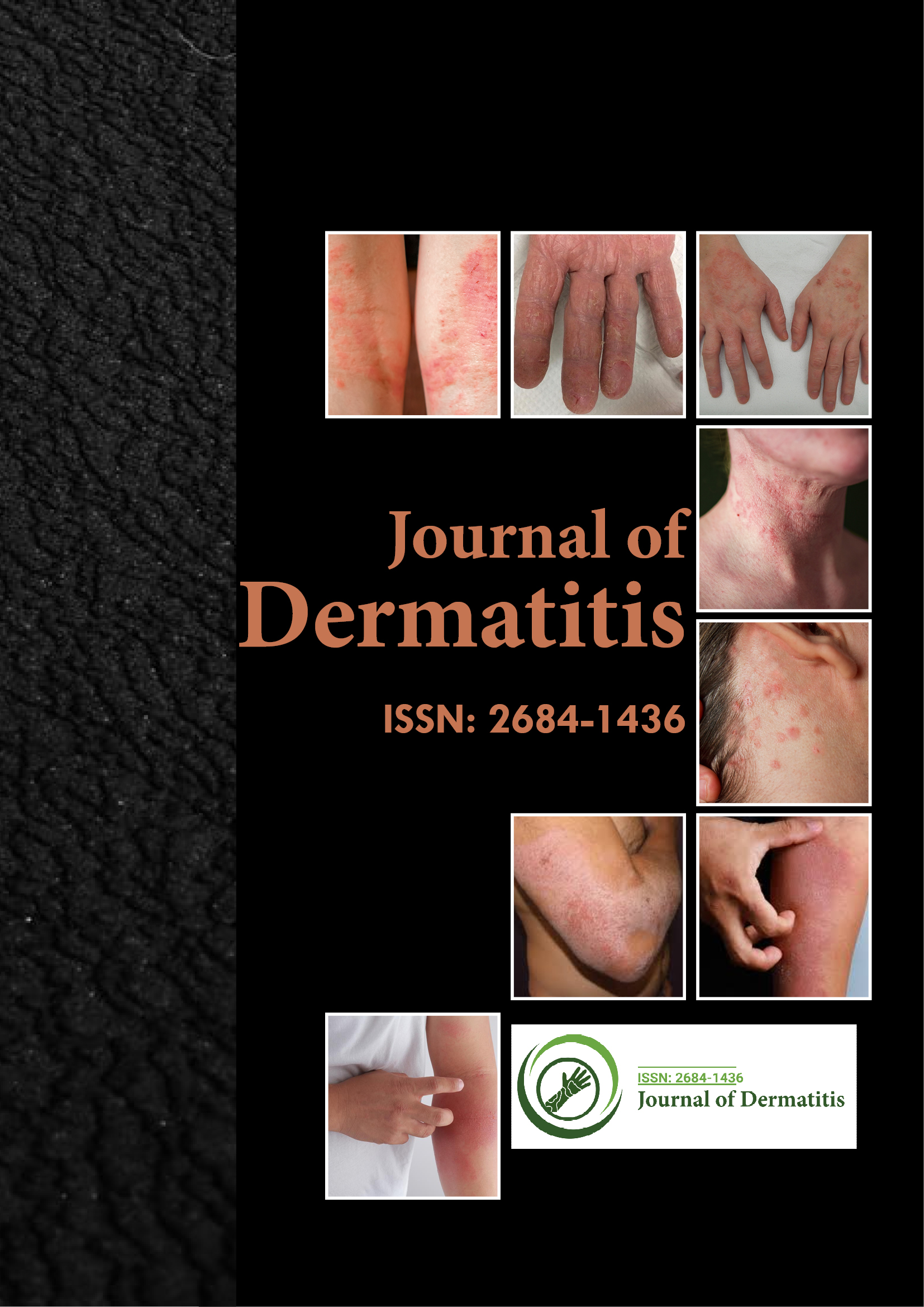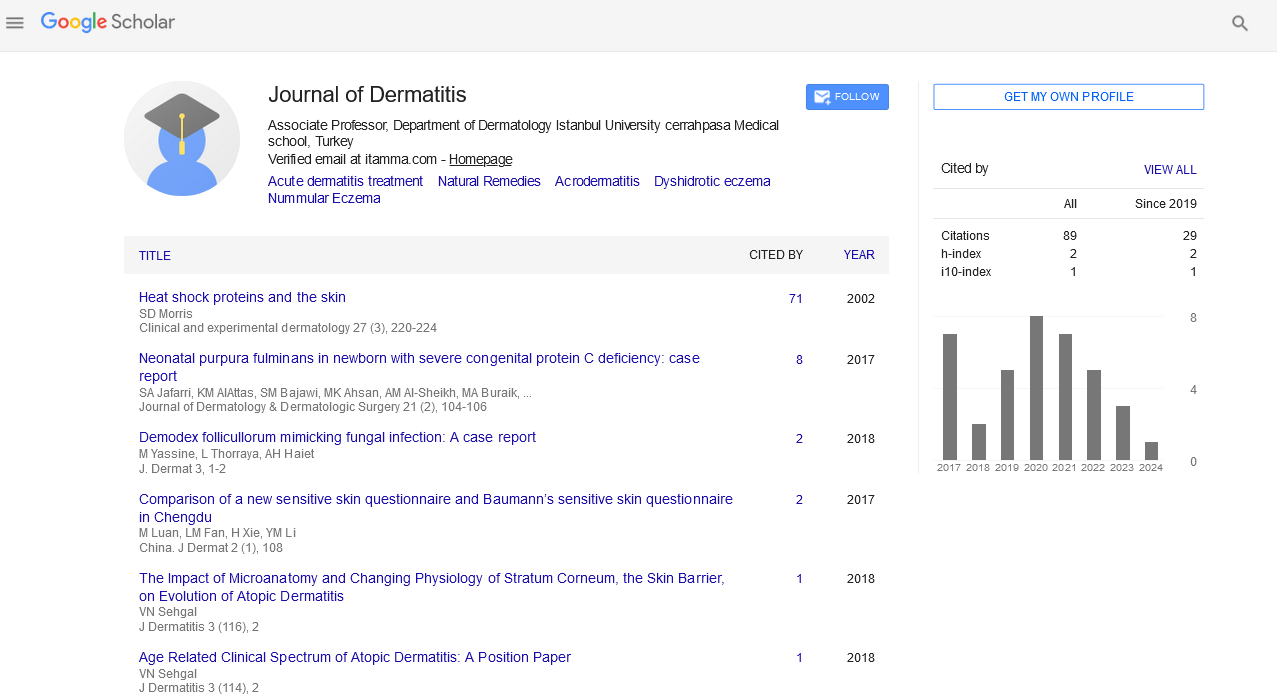Indexed In
- RefSeek
- Hamdard University
- EBSCO A-Z
- Euro Pub
- Google Scholar
Useful Links
Share This Page
Journal Flyer

Open Access Journals
- Agri and Aquaculture
- Biochemistry
- Bioinformatics & Systems Biology
- Business & Management
- Chemistry
- Clinical Sciences
- Engineering
- Food & Nutrition
- General Science
- Genetics & Molecular Biology
- Immunology & Microbiology
- Medical Sciences
- Neuroscience & Psychology
- Nursing & Health Care
- Pharmaceutical Sciences
Commentary - (2025) Volume 10, Issue 2
Efficacy of Novel Topical Agents in the Treatment of Atopic Dermatitis
Achi Morita*Received: 18-Jan-2024, Manuscript No. JOD-24-24646; Editor assigned: 23-Jan-2024, Pre QC No. JOD-24-24646 (PQ); Reviewed: 06-Feb-2024, QC No. JOD-24-24646; Revised: 06-Jan-2025, Manuscript No. JOD-24-24646 (R); Published: 13-Jan-2025, DOI: 10.35248/2684-1436.25.10.272
Description
Atopic Dermatitis (AD), commonly known as eczema, is a chronic inflammatory skin condition characterized by redness, itching, and the formation of dry, scaly patches. The management of atopic dermatitis poses a significant challenge, often requiring a multifaceted approach to address both acute symptoms and prevent relapses. In recent years, there has been a growing focus on the development and evaluation of novel topical agents aimed at providing effective relief for individuals suffering from atopic dermatitis.
The fundamental of atopic dermatitis management has traditionally been the use of emollients and topical corticosteroids. While these treatments can be effective in alleviating symptoms, concerns about long-term use, especially with corticosteroids, have prompted the exploration of alternative therapeutic options. Researchers and clinicians have turned their attention to innovative topical agents that aim to not only manage symptoms but also target the underlying mechanisms contributing to atopic dermatitis.
One class of novel topical agents gaining attention in recent research is calcineurin inhibitors. Tacrolimus and pimecrolimus are examples of calcineurin inhibitors that have been developed as non-steroidal alternatives for the treatment of atopic dermatitis. These agents work by inhibiting calcineurin, a key enzyme involved in the activation of T lymphocytes, thereby modulating the immune response and reducing inflammation.
Clinical studies have demonstrated the efficacy of calcineurin inhibitors in the management of atopic dermatitis. These agents have shown particular promise in treating sensitive areas of the skin, such as the face and neck, where the use of potent topical corticosteroids may be limited due to the risk of adverse effects. Additionally, calcineurin inhibitors have been found to be effective in reducing the frequency and severity of flares, making them valuable in both acute and maintenance phases of atopic dermatitis treatment.
Beyond calcineurin inhibitors, Phosphodiesterase-4 (PDE-4) inhibitors have emerged as another class of novel topical agents with potential benefits for atopic dermatitis patients. Crisaborole, a topical PDE-4 inhibitor, has been approved for the treatment of mild to moderate atopic dermatitis. By inhibiting PDE-4, crisaborole modulates inflammatory responses and helps restore the skin barrier function.
Clinical trials evaluating crisaborole have reported improvements in pruritus, erythema, and overall disease severity. The safety profile of crisaborole has also been favorable, making it a promising option for individuals who may not be suitable candidates for traditional therapies. The introduction of PDE-4 inhibitors represents a shift toward targeted approaches in atopic dermatitis management, addressing specific inflammatory pathways without the use of corticosteroids.
In addition to pharmacological agents, advancements in the field of topical immunomodulators have garnered attention for their potential role in atopic dermatitis treatment. Janus Kinase (JAK) inhibitors, initially developed for systemic use in inflammatory conditions, have been investigated for topical application. Topical JAK inhibitors, such as tofacitinib and delgocitinib, exert their effects by interfering with signaling pathways involved in immune responses and inflammation.
The development of novel topical agents has not only focused on addressing inflammation but also on promoting skin barrier function. Ceramides, fatty acids, and cholesterol are integral components of the stratum corneum, playing an important role in maintaining skin hydration and integrity. Deficiencies in these components are commonly observed in individuals with atopic dermatitis, leading to increased susceptibility to irritants and allergens.
Several novel formulations containing lipid-based components have been designed to replenish and support the skin barrier in atopic dermatitis patients. These formulations aim to restore the balance of lipids within the stratum corneum, ultimately improving skin hydration and reducing susceptibility to external triggers. Research on the efficacy of barrier repair creams and ointments has shown promising results in reducing the frequency of flares and enhancing the overall quality of life for individuals with atopic dermatitis.Conclusion
The efficacy of novel topical agents in the treatment of atopic dermatitis represents a paradigm shift in dermatologic therapeutics. The development of non-steroidal alternatives, such as calcineurin inhibitors, PDE-4 inhibitors, and JAK inhibitors, offers new avenues for managing this chronic inflammatory skin condition. Additionally, formulations designed to support skin barrier function underscore the importance of a comprehensive approach to atopic dermatitis treatment.Citation: Morita A (2025) Efficacy of Novel Topical Agents in the Treatment of Atopic Dermatitis. J Dermatitis. 10:272.
Copyright: �?�© 2025 Morita A. This is an open access article distributed under the terms of the Creative Commons Attribution License, which permits unrestricted use, distribution, and reproduction in any medium, provided the original author and source are credited.

